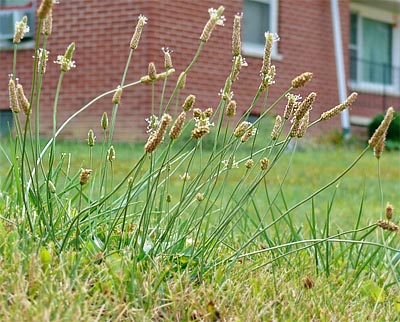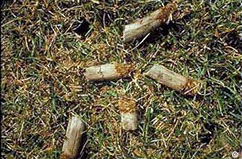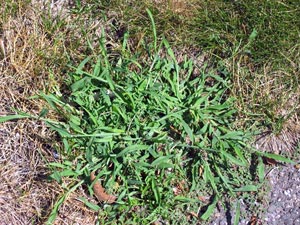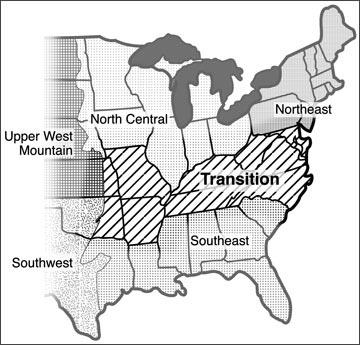Lawn Renovation, Part 1: Making Choices
By Gil Medeiros, Fairfax Master Gardener
 On a bright morning in early August, you rise from your sleep and walk to the street to retrieve your newspaper. You focus your gaze on the paper in its tidy wrapper in order to avoid looking left or right because you might see your lawn. It’s mostly green, but it is certainly not the smooth, uniform greensward that you see in magazines. There are some brown patches, some bare spots, some blades of fescue poking through the crabgrass, some blades of bluegrass among creeping charlie vines, and there are some blades — you can’t tell what — hidden under this yellowish-green mat of grassy-looking stuff that gobbles up more of your lawn each year. You stop; you stare at the bedraggled mess. A wave of embarrassment washes over you. You vow to fix it.
On a bright morning in early August, you rise from your sleep and walk to the street to retrieve your newspaper. You focus your gaze on the paper in its tidy wrapper in order to avoid looking left or right because you might see your lawn. It’s mostly green, but it is certainly not the smooth, uniform greensward that you see in magazines. There are some brown patches, some bare spots, some blades of fescue poking through the crabgrass, some blades of bluegrass among creeping charlie vines, and there are some blades — you can’t tell what — hidden under this yellowish-green mat of grassy-looking stuff that gobbles up more of your lawn each year. You stop; you stare at the bedraggled mess. A wave of embarrassment washes over you. You vow to fix it.
August is a good time to start!
This is the first in a series of three articles on lawn renovation and care. First up: fundamental choices you must make before tackling a lawn renovation project.
There is a shortcut to accomplish the soil testing, lawn measurement, and weed assessment I describe here. You can simply enroll in the Fairfax County Master Gardener Association Home Turf program. For $30, a team of master gardeners will visit your property and do this for you.
Soil
Most of the property in Fairfax County has clay soil with a thin veneer of topsoil. Red clay is not the worst soil in the world (gray clay, on the other hand, is not good), but red clay has some negative aspects.
- It tends to pack down very tightly because clay particles are very small–microscopic in some cases. This means there are no little spaces between soil particles to hold air and water, which are vital for root health.
- Local soils often have an acidic pH. Acidity is great for growing azaleas, hydrangeas, and blueberries, but grass needs a slightly acidic pH of 6.5.
Before you start a lawn renovation, you should do a soil test. (See our article on soil testing.) The soil test will tell you exactly what to do to achieve the optimum pH and levels of most nutrients (except nitrogen) required to grow healthy grass.
You should also assess the compaction of your soil. If you can push a screwdriver three inches into the soil with normal effort (driving it with a hammer is not normal effort), you probably do not need to aerate.

Soil cores after aeration
Measure your lawn area
There is a good reason to measure your lawn. Most of the advice you will receive regarding fertilization, liming, chemical application, and seeding is expressed in terms of how much material you need to apply per 1,000 square feet of lawn. If you don’t know how much lawn you have, you cannot calculate the amounts of material to apply.
As you look at your property, you see a daunting combination of planting beds, trees, walkways, driveways, the house, and other structures. You don’t need to hire a surveyor; the measurement does not have to be perfect. Make a hand-drawn map of your property and break down the area into smaller squares, rectangles, right triangles and circles that approximate the real shapes. Then you will need to measure the dimensions of these shapes using a measuring tape, pacing, or whatever you prefer and calculate the areas.
Add together the areas of all the lawn shapes, and subtract the areas of the house, driveways, walkways, etc., where there will be no grass. Remember that it does not have to be perfect.
| Rectangle | Area = length x width |
| Right triangle | Area = 1/2 length x width |
| Circle | Area = 3 x radius squared |
Sun exposure
When you make your map, it is wise to pay attention to sun exposure on various sections of your lawn and take notes on the map. This is important because you may need to use different grass seed for different locations in your yard (more about grass seed later).
Weeds
The main problem with the weeds in lawn renovation is they occupy space where you will need to apply seed. Seed needs to come in contact with soil for it to germinate. For that reason, the weeds have to go. You can remove them mechanically by raking them up, pulling them up, or renting a machine that cuts them off at the surface.

Large Crabgrass shown here must be pulled to expose the soil.
The other herbicide option is to control the weeds selectively (i.e., kill the weed without affecting the good grass). This can be a very complicated proposition because each type of weed is best controlled in a different way. Therefore, identification is crucial. Selective weed removal is difficult to do as part of lawn renovation because the timing is not right for the selective herbicides to be effective. (Look for more about selective weed killing in Part 3 of this series in October.)
Grass

In the Transition Zone we can grow northern cool season or southern warm season grasses. However, neither type is perfectly adapted for our region.
Cool season grass or warm season grass?
The Mid-Atlantic region is in the Transition Zone for turfgrass.
| Cool Season and Warm Season Grasses | |
| Northern grasses that grow best in spring and fall in the Mid Atlantic. | Southern grasses that grow best in summer in the Mid Atlantic. |
| Best for Sun: Tall fescue | Best for Sun: Zoysia | Best for Shade: Fine-leafed fescue | Best for Shade: None |
| Advantages: Fescues do reasonably well in our area. Many types are available. Some have very deep green color. Some may stay green all winter. They are somewhat tolerant of shade. Cool season lawns are easy to start from seed or sod. Disadvantages: May go dormant and be damaged during exceptional summer drought. Susceptible to some diseases. |
Advantages: Zoysia is low maintenance, out-competes most weeds, loves the heat of summer, and is disease resistant. Stays green during summer drought. Disadvantages: Takes years to establish, turns brown for 3-5 months per year, little tolerance for shade. Can be damaged by an exceptionally cold winter. |
Sun or shade?
This selection will be based on the assessment you made when you measured your lawn. It is a waste of time and money to attempt to grow grass that requires six hours of sun per day in an area that only sees two. Likewise, it is almost impossible to grow grass of any type directly under a spreading maple or beech tree. You must adjust your expectations to meet reality. Therefore, this is not so much a choice but a rational decision based upon your estimate of sun exposure.
Most grass seed blends and mixes are packaged as “Sun,” “Sun and Shade,” or “Shade.” These are described below.
| Typical Labelling for Type of Grass You Will Need | How Much Sun? | Typical Grass Types |
| Sun | Six or more hours of sunlight | Tall fescue and/or bluegrass. |
| Sun and Shade | Three to six hours of sunlight | Tall fescue and/or fine-leafed fescue. |
| Shade | Less than three hours | Fine-leafed fescue and/or hard fescue. |
If you have a small townhouse lawn, sod may be your best bet. It costs more per square foot than seed, but you will have an instant lawn with less effort. Sod can be put down anytime the ground is not frozen. In this area, sod is available for tall fescue, fine-leafed fescue and blends of fescue and bluegrass. For larger lawns, you will probably choose to apply seed.
Cheap seed or more expensive seed?
No surprise here; you get what you pay for. Cheap seed is often for grass that is intended for sale in many parts of the county but is not specifically bred for Middle Atlantic heat, humidity, and occasional drought conditions. It will not be resistant to common diseases in our area. Cheap seed often has a lower rate of germination and a higher percentage of weed seed. Sometimes cheap seed even contains annual ryegrass that germinates fast and will look great in the fall but will not come back next spring. Garden centers, not big box stores, usually stock seed blends that have been formulated specifically for our area. That is your best bet. If you decide to shop for seed at a big box store, you should favor the more expensive blends. Make sure the package says the seed is intended for sale in 2015. You do not want seed that has been around on a store shelf since 2014. Seed does not get better with age.
Coming in September 2015: Part 2 — How to prepare the soil. How to apply the seed or sod and water it.
Coming in October 2015: Part 3 — How to care for your newly planted lawn.
References
• Virginia Turfgrass Variety Recommendations
• Spring and Summer Lawn Management Considerations for Cool-Season Turfgrasses, VCE
Publication 430-532
• Spring and Summer Lawn Management Considerations for Warm-Season Turfgrasses, VCE
Publication 430-533
• Aerating Your Lawn, VCE Publication 430-002